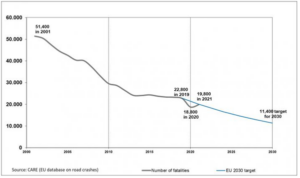12/08/2024
The Vital Connection Between Pavement Testing and Road Safety!
Financially, maintaining good road conditions is more cost-effective than reconstructing deteriorated sections. This blog post highlights the crucial safety implications of well maintained roads, emphasizing the significance of safety considerations.
The Grave Reality of Road Accidents
Road accidents are among the leading causes of injuries and deaths worldwide, resulting in approximately 1.19 million fatalities and 20-50 million long-term disabilities annually, according to the Global Status Report on Road Safety 2023 by the World Health Organization. Although efforts to improve road safety are showing positive effects, the global goal of at least reducing 50 percent of road traffic deaths and injuries by 2030 remains distant.
The European Commission data indicates the following values for fatalities in Europe.
Reduced traffic from the COVID-19 pandemic restrictions led to a decrease in fatalities in 2020 compared to 2019, but numbers rose again in 2021. The following chart from CARE (EU Road Accident Database) shows the number of road fatalities per million inhabitants by country in Europe during 2021.

The following chart from CARE (EU Road Accident Database) shows the number of road fatalities per million inhabitants by country in Europe during 2021.

If we take a closer look at the numbers Malta is the best-performing country with only 17 road deaths per million inhabitants, though subject to annual fluctuations. Following Malta are the Nordic countries, with Denmark ranking third. Conversely, Romania has the worst rate in the EU, with 93 road deaths per million inhabitants.
The causes of these road accidents can be broadly categorized into reasons including human error, road conditions, and vehicle conditions.
Although human error is the leading cause of road traffic accidents, road conditions play a significant role and can be managed much ore easily. In countries that prioritize pavement conditions, only 4% of all road accident-related fatalities are attributed to poor road conditions. In contrast, in other countries, this number can exceed 30%, highlighting the significant potential to save lives with improved road conditions.
Key Pavement Surface Conditions Affecting Safety
The three most important pavement surface condition characteristics related to traffic accidents are; roughness, rutting, and skid resistance.Studies have shown a direct link between these factors and accident rates.
Pavement Friction (Skid Resistence)
Pavement friction, often referred to as “skid resistance,” is vital for safe vehicle maneuvers such as steering, braking, and acceleration. Skid resistance on wet pavement is particularly crucial, as nearly 20% of all road accidents occur on wet surfaces. Several studies have demonstrated that accident rates decrease with increasing values of skid resistance. The current state of practice for high-speed friction measurement relies on either the locked-wheel skid tester (LWST) or Continuous Friction Measurement Equipment (CFME). The LWST uses a non-continuous method to measure friction, while the CFME can test 100 percent of the pavement and is highly effective for ramps, curves, and intersections where friction demand is higher.
Macrotexture is one of the main factors affecting pavement friction, especially at higher speeds. It provides drainage channels for water to be expelled between the tire and the pavement. High-speed methods that utilize single-spot laser or line-laser technology are particularly suited for network-level data collection of macrotexture.
Influence of Pavement Roughness on Safety
Pavement roughness affects vehicle ride quality, vibrations, operating speed, tire wear, and overall vehicle operating costs. The International Roughness Index (IRI) is the most common parameter used to indicate pavement roughness. Numerous studies have shown a strong correlation between higher IRI values and increased crash rates, particularly at night and in wet conditions.
Rutting – A Hidden Danger
Rutting, the longitudinal plastic deformation of the roadway can trap water during rainfall, leading to hydroplaning and reduced skid resistance. Increased rut depth has been shown to correlate with higher crash rates, especially under adverse weather conditions.
The role of pavement testing equipment
Dynatest offers cutting-edge tools like the Pavement Friction Tester (PFT 1295) and the Continuous Friction Measurement Equipment (HFT 6875H) to accurately measure pavement friction conditions. The Road Surface Profilers (RSPIII and RSPIV) can assess macrotexture, roughness, and rutting, providing comprehensive data for maintenance and safety decisions.
Important question?
Could some of the 1.19 million accidents that occurred last year have been avoided by monitoring pavement conditions and applying timely maintenance? We believe so. Road owners and governments are urged to use the right tools for pavement testing. This approach ensures greater safety, enhanced user comfort, and extended pavement lifespan.
Data shows that we are heading in the right direction, but a more proactive approach to safety should be adopted. Measurements of friction, roughness, and rutting should guide maintenance and treatment decisions, rather than relying solely on a reactive approach based on crash occurrences.
By focusing on these critical safety implications, we can significantly enhance road safety and reduce the financial burden on road users and owners alike.
Let’s pave the way for safer roads by prioritizing pavement testing and maintenance.
Leave a comment